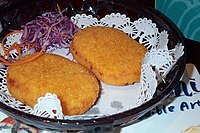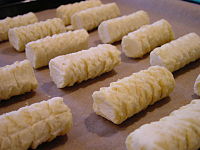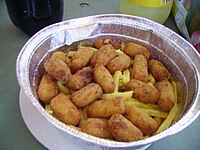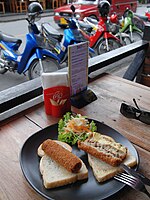Croquette
This articleneeds additional citations forverification.(January 2012) |
 Cylindrical croquettes | |
| Region or state | France |
|---|---|
| Main ingredients | Ground meat,shellfish,fish,ham,cheese,mashed potatoes,vegetables,béchamelorbrown sauce |
Acroquette(/kroʊˈkɛt/)[1]is adeep-friedroll originating inFrench cuisine,consisting of a thick binder combined with a filling, which is thenbreaded.[2]It is served as aside dish,asnack,orfast foodworldwide.
The binder is typically a thickbéchamelorbrown sauce,mashed potatoes,[3]wheat flour or wheat bread.[4]The binder may be mixed with or stuffed with a filling. Typical fillings include finely choppedmeat,seafood,cheese,rice,mushrooms,and variousvegetables,which may be combined withseasoningssuch asherbsandspices.Sweet croquettes may use apastry creambinder and be filled withfruit.[5][6][7]
Croquettes may also be formed in other shapes, such as disks, ovals, or balls.
Etymology[edit]
The wordcroquetteis French, derived fromcroquer,meaning 'to crunch'.[8]In the 18th century, it was typically spelledcroquet.[7]
Origins[edit]
A 17th-century recipe for croquettes (croquets) byFrançois Massialotbinds a filling of meat,truffles,marrow,bread crumbs,and cheese with egg, then breads and fries them inlard.They may be as large as an egg or as small as awalnut,and can be served as anhors-d'œuvreor as agarnish.[9]They are mentioned in a 1706 English dictionary.[7][10]One 18th-century recipe uses just a batter, rather than a béchamel binder.[11]Croquettes of the modern type, with a thick binder, are documented in an 1822 English cookbook by the French cook Louis Eustache Ude.[12]
Asia[edit]
India[edit]

A potato-filled croquette calledaloo tikki,[13]which originated in theIndian subcontinent,is very popular inNorthern Indiaand is usually served with astew.They are mostly eaten as snacks at home and are also popularly sold by roadside vendors. InWest Bengal,there are two popular types of croquettes called chop and cutlet. Vegetable chop is prepared using a medley of mashed vegetables like boiledbeetroot,carrot,andgreen peas,which is held together by potato, then breaded and deep fried. A cutlet is like a chop, but skips the potato binding on its inside. A mutton cutlet is made of mincedgoat meatmixed with spices that is breaded and deep-fried.McDonald'sin India serves a fast-food variation of aloo tikki inside ahamburgerbun. Meat croquettes calledkebabsare made with mincedmutton.Lightly spiced beef croquettes are a popular snack and appetiser among the Christian communities inGoaandKerala.[14]
Sri Lanka[edit]
There are two main types of croquettes in Sri Lanka.[15]The first type is called rolls, and is a popular cylindrical bakery product. The rolls are commonly filled with a mixture of fish, potatoes and spices, and hence called fish rolls. Chicken is also sometimes used. The second type is called cutlets, which are spherical and generally made for festive occasions.
China[edit]
Japanese-style potato croquettes ( Nhật thức Coca bánh ) are popular in China. They are made with mashed potatoes,corn,and sometimes meat.
Indonesia[edit]
Therecipes Indonesia(Dutch), made of mashed potato filled with minced chicken orragout,is one of the most popular snack items inIndonesia,introduced duringDutch colonial rule.[16]Thekroketis made by putting the chicken filling inside a mashed potato ball, which is then breaded and fried.
Japan[edit]
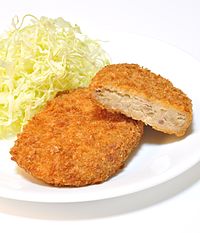
A relative of the croquette, known askorokke,[17][18](コロッケ) is a popular fried food; widely available in supermarkets, convenience stores and butcher shops, as well as from specialtykorokkeshops.[19]Generally patty-shaped, it is mainly made of potatoes with other ingredients including vegetables (such as onions and carrots) and usually less than 5% meat (e.g. pork or beef).[18]It is often served withtonkatsu(とんかつ) sauce. Cylindricalkorokkeare also served; they more closely resemble the French version, where seafood (prawns or crab meat) or chicken in white sauce (ragout) is cooled down to make it harden before the croquette is breaded and deep-fried. When it is served hot, the inside melts. This version is called "creamkorokke"(クリームコロッケ) to distinguish it from the potato-based variety. It is often served with no sauce or tomato sauce. Unlike its French cousin, croquettes made mainly of meat are not calledkorokkeinJapan.They are calledmenchi katsu(メンチカツ), short for minced meat cutlets.
The dish likely was imported to Japan in the late 1800s along with other Western dishes.[18]
The town ofAssabu, Hokkaidoholds theGuinness World Recordfor world's largest croquette.[20]
South Korea[edit]
The Korean version of croquettes,goroke(고로케) orkeuroket(크로켓),[21]are sold in many bakeries inSouth Korea.The most common type is deep-fried rolls stuffed withjapchae(잡채) ingredients orchicken curryand mashed potato with vegetable salad.Gorokeis sometimes filled withkimchi,pork, andbulgogiingredients. Many Korean stores advertise thegorokeas a French product and they are sold in most European-style bread stores in South Korea.
Europe[edit]
Belgium[edit]
Kroketten/croquettescan be served as a side or main dish. They are usually savoury and filled withmashed potatoes.[22]The two most popular Belgian croquettes have a thick bechamel filling mixed withgrey shrimps"garnaalkroketten/croquettes de crevettes" or cheese "kaaskroketten/croquettes de fromage".[23]The prawn filling seems to have first appeared in 1922, and became popular in the 1950s.[24]As a main dish, they are usually served with asalad,friedparsleyandfrites.
France[edit]
Theragout-filled dish was regarded as a French delicacy. It was first described in a recipe from 1691 by the chef of the French kingLouis XIV,using ingredients such astruffles,sweetbreads,andcream cheese.[25]From the 1800s onward, it became a way to useleftoverstewed meat.
They are traditionally made from a base of thickbéchamel,veloutéor potatoespuréein which different ingredients can be included (ham, cheese, meat, vegetables).[26]Croquettes made from a base of rice are also common and several recipes can be found inAntonin Carêmebooks.[27]
Germany, Austria, and Switzerland[edit]

The German word isKroketten(singularKrokette). In the German speaking countries, this usually refers to plain potato croquettes.[28]They are served as a side dish in restaurants but are also available frozen in supermarkets.
Hungary[edit]
Krokettis a small cylindrical croquette similar to the Czech variety: potatoes, eggs, flour, and butter, seasoned withnutmegand salt and deep-fried in oil. This variety is available in most restaurants as a side dish and can also be bought frozen.[citation needed]When made withcottage cheese,they are calledtúrókrokett.[29]
Italy[edit]

In Italy,crocchette(known in the South ascrocchè[30]) is made mainly with crushed potatoes or vegetables such asaubergines(crocchette di melanzane).Crocchetteis derived from the croquettes introduced in the area by the French in the 18th century;[31]inNeapolitanandSiciliancuisine they are made frommashed potatoandegg,which is covered in breadcrumbs and fried.Crocchetteare typically a Southern Italianstreet food,ubiquitous atfriggitoriespecializing in fried foods, the Italian equivalent of fish and chip shops. Ricearancini(typical ofSicily),supplì(Roman cuisine) andMilaneserice and saffroncrocchetteare particularly well-known in Italian cuisine. InEmilia-RomagnaandPiedmont,crocchetteare usually filled with chicken, while inCalabriapolpette di risoare stuffed with rice and cheese (usuallyParmesanorpecorino).
Ireland[edit]
Plain potato croquettes are available frozen or refrigerated in most supermarkets. They are also homemade, usually with the addition of chopped onion.
The Netherlands[edit]

AfterWorld War II,several suppliers started mass-producing croquettes[32]filled with beef. The croquette (kroketinDutch) subsequently became even more popular as a fast food; meat ragout was covered in breadcrumbs and subsequently deep-fried. Its success as a fast food garnered its reputation as a cheap dish of dubious quality, to such an extent thatDutchtongue-in-cheekurban mythsrelate its "allegedly mysterious content" tooffaland butchering waste.[33]Research in 2008 showed that 350 millionkrokettenare eaten in the Netherlands every year. An estimated 75% of all Dutch people eat them, resulting in 29krokettenper person per year on average, being the 2nd most popular Dutch snack after thefrikandel.The major consumers are between 35 and 49 years old.[34]
The success of the croquette led to a whole series of food products resembling the croquette, but with other types of fillings, such as noodles, rice andkidney,and with names likebamibal,nasibal,andnierbroodje.Variants of the croquette which specify the kind of meat can also be found, likerundvleeskroket(made with beef) andkalfsvleeskroket(made withveal). Also popular in Dutch snack bars are thesatékroket(where the filling consists of a peanutsataysauce and shredded meat in a ragout) and thegoulash kroket.A smaller round version of the standard beef or veal croquette, thebitterbal,[32]is often served withmustardas a snack in bars and at receptions. Potato croquettes and potato balls (similar to potato croquettes, but small and round) can be bought frozen in most food stores.[35]

Broodje kroket,a croquette on a bread roll, is sold in restaurants, snack shops, and by street vendors. The popularity of thekroketin the Netherlands is such that evenMcDonald'ssells their version on a bun as "McKroket".[36]
Poland[edit]
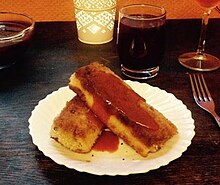
Croquettes inPolandare typically made from a thin, rolledcrepe-typepancake stuffed with meat, mushrooms,cabbage,sauerkraut,or some combination of those ingredients.[37]The croquette is lightly pan-fried before serving.[38] Some recipe variations also require the croquette to be covered in breadcrumbs before frying and served with a clear soup e.g. "barszcz", similar toborscht.[39]
Portugal[edit]
Croquetes[40]are cylindrical, covered in breadcrumbs, and deep-fried. They are usually made with white sauce and beef, sometimes mixed with varying amounts of pork, and frequently with somechouriço,black pepperorpiri-pirito add more flavour. Seafood, fish (other thancodfish) and vegetarian (potato) croquetes are also eaten inPortugal,but those have other names (such asrissol,pastel,empada), thus the name croquete refers only to the Dutch-style beefcroquette.
Russia[edit]
The widespread mincedcutlet(Russian:котлета рубленная,romanized:kotleta rublennaya)[41]is made of minced meat (beef or pork or a mixture of both; chicken,turkey,or fish), bread, eggs, white onions, salt and spices, shaped as a meat patty and pan-fried. Bread is added in amounts up to 25% of meat, adding softness to the final product and also making it cheaper to produce. ThePozharsky cutletis a well-known variety of such cutlets in which minced meat is mixed with butter.
Spain[edit]
Traditionalcroquetas[42]in Spain are made with thick béchamel. They are one of the most typicaltapasdishes,[43]especially filled withjamón,chicken orsalt cod.[44][45]Also, many bars and restaurants may offer novel, less traditional versions of croquettes with more varied fillings and ingredients such asapple,wild mushrooms,morcilla(blood sausage), cheeses,tuna,[46]cuttlefish(using its ink to give color and flavour), etc.Croqueteríasare restaurants that specialize incroquetas.
United Kingdom[edit]
Croquettes[47]are available frozen[48]or refrigerated in most supermarkets, typically with potato filling.
Caribbean[edit]
Puerto Rico[edit]
Croquettes are typically made from ham, codfish or chicken[49]inPuerto Rico,where they are dipped in what is colloquially known as "mayo-ketchup", a variation offry sauce.Frozen croquettes are sold in supermarkets in Puerto Rico. There are versions oftaro,cornmeal (calledsorullos),breadfruit,yams,andcassavein replacement of wheat flour or potato.
Cuba[edit]
Cubancroquettes are nearly identical to the Puerto Rican croquettes, in that they are also made from ham or chicken.[50]There is also a common cheese and potato variation, and they are sometimes made with fish.
Dominican Republic[edit]
Dominicancroquettes are nearly identical to the Cuban and Puerto Rican croquettes, in that they are typically made from ham or chicken, but there is a common cheese and potato variation, a beef variation, and they are also sometimes made with fish.
Aruba[edit]
Aruban croquettes are commonly made with mashed potato, ground beef, shellfish, and fish. They are eaten as an early morning breakfast or as snacks any time of the day. They are considered one of the island's cultural foods.[51]
North America[edit]
Mexico[edit]
Croquettes are usually made of tuna or chicken[52]and potatoes. In southern Mexico, a variety is made with fresh cheese,plantain,and black beans.
United States[edit]
Adeviled crab(croqueta de jaiba) is a particular variety of ablue crabcroquette fromTampa, Florida.The crab meat is seasoned with a uniqueCuban-styleenchiladaorsofritosauce (locally known aschilau[53]), breaded with staleCuban breadcrumbs, formed into the approximate shape of aprolate spheroid,and fried. It is meant to be eaten with one hand. It originated in the immigrant community ofYbor Cityduring a cigar workers' strike in the 1920s[54][55][56]and is still popular in the area.
South America[edit]
Brazil[edit]
Croquetes,[57]primarily made from beef, are a common snack in many parts ofBrazil.[58]Thecoxinhais a popular chicken-based croquette.[59]
Ecuador[edit]
FromRiobamba,llapingachosare potato cakes with a cheese filling, fried in oil withachiote,and served with apeanutsauce.
Uruguay[edit]
Called "croquetas" in Spanish, the most popular stuffing are mashed potatoes (croquetas de papa), ham and mozzarella cheese (croquetas de jamón y queso), and rice (croquetas de arroz). Sometimes, the rice ones have herbs and little ham cubes. Generally, their shape is cylindrical and medium sized; but larger spherical ones also can be seen (especially with rice stuffing). They are deep-fried in oil.
Croquetas are very common: they are available in almost every bakery, supermarket or food shop, and many people cook them at home as a side dish or even a main dish. In modern restaurants, more sophisticated croquettes (e.g. withserrano hamand a mixture of cheese orsalmon) usually come with a more elaborate sauce as a dip (e.g.sweet chili sauce) and are ordered as starters.
Colombia[edit]
In Colombia croquettes are commonly referred to as "papa rellena",which translates as stuffed potato. They consist of a mix of roughly mashed potato, seasoned shredded or ground beef and an egg. This mix is then lightly battered and deep fried. They are served in bars, casual restaurants, and at home for a celebration or party. They usually come with a side of homemade or bottledchili sauce.
Gallery[edit]
-
Circular croquettes
-
Cylindrical potato croquettes
-
Croquetas fritas
-
TwoDutchkroketten,one cut open to show the beef-ragout filling;Chiang Mai,Thailand
See also[edit]
- List of deep fried foods
- List of potato dishes
- Krokettenmotie
- Cuchifritos– Various fried foods prepared principally of pork
- Bitterballen– Savoury Dutch meat-based snack
- Fritter– Fried pastry usually consisting of a portion of batter with a filling
- Rissole– European dish of meat covered in pastry
- Chicken cordon bleu– Meat and cheese dish
- Aranciniandsupplì– Italian snack foods
References[edit]
- ^"croquette noun - Definition, pictures, pronunciation and usage notes - Oxford Advanced Learner's Dictionary at OxfordLearnersDictionaries".oxfordlearnersdictionaries.
- ^Nagao, Keiko; Hatae, Keiko; Shimada, Atsuko (1997)."Occurrence of Ruptures on the Surface of Foods During Frying".Journal of Texture Studies.28(1): 27–46.doi:10.1111/j.1745-4603.1997.tb00100.x.ISSN0022-4901.
- ^Kashima, Tomoko; Masumoto, Shimpei; Ishii, Hiroaki (2009). "Evaluation of Menu Planning Capability Based on Multi-dimensional 0/1 Knapsack Problem of Nutritional Management System".IAENG International Journal of Applied Mathematics.39:163–170.
- ^Khaustova, Tetyana; Fedak, Natalia; Andreeva, Svetlana; Dikhtyar, Aliona (2018-12-10)."Studying the influence of hydrothermal treatment parameters on the properties of wheat flour in the technology of a croquette mass".Eastern-European Journal of Enterprise Technologies.6(11 (96)): 77–82.doi:10.15587/1729-4061.2018.150072.ISSN1729-4061.
- ^Prosper Montagné,Larousse gastronomique:the encyclopedia of food, wine & cookery,Crown, 1961. (translation of the 1938 edition)OCLC413918,s.v.,p. 325
- ^"Eat this Word: Croquettes".James Beard Foundation.25 June 2009.Retrieved9 March2023.
- ^abcAlan Davidson,Oxford Companion to Food,1999,s.v.,p. 229
- ^Lembi, Dante P.; Kaulfers, Walter V. (1940)."French Expressions Used in English: An Exploratory Vocabulary Unit for the First Week of Beginning French or General Language".The Modern Language Journal.25(3): 174–180.doi:10.1111/j.1540-4781.1940.tb00635.x.
- ^François Massialot,Le Cuisinier royal et bourgeois,Paris, 1693,p. 227
- ^Phillips, Edward (1720).The new world of words. [&c.].J. Philips.
- ^Menon(pseud.),La cuisinière bourgeoise,1769,p. 42
- ^Ude, Louis Eustache (1822).The French Cook.J. Ebers. p. 208.
- ^"Stuffed Aloo Tikki Recipe - How To Make Stuffed Alu Tikki".indianfoodforever.25 September 2019.
- ^"Prepare croquettes".goaholidayhomes.Archived fromthe originalon 30 July 2011.Retrieved2023-03-09.
- ^"Welcome to GOV.LK:: Home Page".gov.lk.
- ^Yusuf, Munif (2018-06-29)."Indonesian Influence in Dutch: A Cultural and Linguistic Perspective".International Review of Humanities Studies.1(1).doi:10.7454/irhs.v1i1.50(inactive 2024-04-24).ISSN2477-6866.
{{cite journal}}:CS1 maint: DOI inactive as of April 2024 (link) - ^Hara, Reiko (2006).International cuisine: Japan(1st ed.). London: Hodder Arnold.ISBN978-1-4441-6547-0.OCLC778802068.
- ^abcWashington, Bryan (2022-06-08)."A Foolproof Recipe for Korokke".The New York Times.ISSN0362-4331.Retrieved2023-03-09.
- ^Palmer, Edwina (2016-01-01).Harima Fudoki: A Record of Ancient Japan Reinterpreted, Translated, Annotated, and with Commentary.BRILL.doi:10.1163/9789004269378_004.ISBN978-90-04-26937-8.
- ^"Japanese town cooks up world's largest croquette - UPI".UPI.18 August 2022.Retrieved2023-03-09.
- ^KBS, Busan (2005)[1]Archived2012-07-08 atarchive.today
- ^Cismaru, Joanna (2019-05-31)."Potato Croquettes".Jo Cooks.Retrieved2022-09-23.
- ^"Belgium in Brief: Shrimp or Cheese Croquette?".The Brussels Times.6 August 2021.Retrieved2023-03-09.
- ^"The prawn croquette, Belgium's hidden gem".La Prensa Latina Media.2022-04-10.Retrieved2023-03-09.
- ^"'De kroket leeft als nooit tevoren' | Radio Nederland Wereldomroep ".Archived fromthe originalon 2012-02-10.Retrieved2012-06-18.
- ^Escoffier, Auguste; Gilbert, Philéas; Fetu, Emile (1948).Le guide culinaire: aide-mémoire de cuisine pratique(in French). E. Flammarion.
- ^Carême, Marie-Antoine (1815).Le Pâtissier royal parisien ou Traité élémentaire et pratique de la pâtisserie ancienne et moderne,...: suivi d'observations utiles aux progrès de cet art, d'une série de plus de soixante menus et d'une revue critique des grands bals de 1810 et 1811(in French). J. G. Dentu.
- ^"Kroketten".ESSEN UND TRINKEN.19 July 2021.
- ^"Manchester United legend: Maguire is a nightmare for England at the World Cup 2022".November 11, 2022. Archived fromthe originalon November 11, 2022.RetrievedNovember 11,2022.
- ^Barone, Michele; Pellerito, Alessandra (2020), Barone, Michele; Pellerito, Alessandra (eds.),"Palermo's Street Foods. The Authentic Pane e Panelle",Sicilian Street Foods and Chemistry: The Palermo Case Study,SpringerBriefs in Molecular Science, Cham: Springer International Publishing, pp. 71–81,doi:10.1007/978-3-030-55736-2_5,ISBN978-3-030-55736-2,S2CID226750085,retrieved2021-04-09
- ^Larousse (2017).Le grand Larousse gastronomique(in French). Larousse.ISBN978-2-03-594805-2.
- ^ab"Real Dutch kroket and bitterbal".coquinaria.nl.9 January 2006.
- ^H. van Dam:Het volkomen krokettenboek,publisher: Nigh & Van Ditmar, 2011
- ^"Nederland neemt een betere kroket - Foodlog".foodlog.nl.
- ^Pinho, Maria Gabriela M.; Lakerveld, Jeroen; Harbers, Marjolein C.; Sluijs, Ivonne; Vermeulen, Roel; Huss, Anke; Boer, Jolanda M. A.; Verschuren, W. M. Monique; Brug, Johannes; Beulens, Joline W. J.; Mackenbach, Joreintje D. (2020-11-24)."Ultra-processed food consumption patterns among older adults in the Netherlands and the role of the food environment".European Journal of Nutrition.60(5): 2567–2580.doi:10.1007/s00394-020-02436-5.ISSN1436-6215.PMC8275501.PMID33236180.
- ^"Beyond 'Royale with Cheese' - McKroket (3) - FORTUNE".money.cnn.Archived fromthe originalon 2012-10-12.Retrieved2013-11-19.
- ^Derek, Marta (January 2021)."Nature on a Plate: Linking Food and Tourism within the Ecosystem Services Framework".Sustainability.13(4): 1687.doi:10.3390/su13041687.
- ^"Recipe - Polish Croquettes".foodcult.
- ^"Krokiet (Croquette- fried breaded meat-filled crepe pancake)".polishfoodrecipes.blogspot.16 July 2007.
- ^Alves, Jose."Receitas - Croquetes de Batata - Roteiro Gastronómico de Portugal".gastronomias.
- ^http:// russianfoods.ru/recipes/item0022f/_rus_/default.asp%7Carchiveurl=https://web.archive.org/web/20090210044101/http://russianfoods.ru/recipes/item0022F/_rus_/default.asp
- ^Schneider, Edward (7 October 2008)."Making Spanish Croquettes".The New York Times.
- ^Batlle-Bayer, Laura; Bala, Alba; Roca, Mercè; Lemaire, Elodie; Aldaco, Rubén; Fullana-i-Palmer, Pere (2020-10-20)."Nutritional and environmental co-benefits of shifting to" Planetary Health "Spanish tapas".Journal of Cleaner Production.271:122561.doi:10.1016/j.jclepro.2020.122561.hdl:10902/19007.ISSN0959-6526.S2CID224979446.
- ^Fernández-Armesto, Felipe (2023-02-24)."Seductive croquetas".The Critic Magazine.Retrieved2023-03-09.
- ^White, Keri (2023-02-20)."Basque-Style Croquettes".Jewish Exponent.Retrieved2023-03-09.
- ^"Receta de Croquetas de atún fritas".recetasgratis.net.
- ^"Definition of CROQUETTE".merriam-webster.Retrieved2023-03-09.
- ^"Morrison's own label potato croquettes receive top British Frozen Food Award".allbusiness.Archived fromthe originalon September 26, 2008.
- ^"Ham Croquettes".thelatinkitchen.
- ^Peláez, Ana Sofía; Silverman, Ellen (28 October 2014).The Cuban table: a celebration of food, flavors, and history(First ed.). New York.ISBN978-1-250-03608-7.OCLC883510935.
{{cite book}}:CS1 maint: location missing publisher (link) - ^"Bitterbal (Meat Croquettes)".Visit Aruba.9 April 2021.Archivedfrom the original on 2012-09-12.Retrieved9 April2021.
- ^"Croquetas de pollo (Mexikanska kycklingkroketter)".matklubben.se.
- ^"Deviled crab croquettes a tasty Tampa tradition - TBO".tbo.Archived fromthe originalon 2012-10-09.Retrieved2011-07-02.
- ^""Bitter Strikes Brought Deviled Crabs" - Cigar City Magazine ".Archived fromthe originalon July 22, 2012.
- ^""A venerable Tampa tradition" - foodmuseum ".Archived fromthe originalon May 12, 2008.
- ^Edge, John T. (26 April 2011)."Tampa's Favorite Street Food: Devil Crabs".The New York Times.
- ^Croquetas de atún tradicionales de EspañaLobbymarket.es
- ^Araujo, Marina Campos; Cunha, Diana Barbosa; Bezerra, Ilana Nogueira; de Castro, Maria Beatriz Trindade; Sichieri, Rosely (2017)."Quality of food choices of Brazilian adolescents according to individual earnings".Public Health Nutrition.20(17): 3145–3150.doi:10.1017/S1368980017002099.ISSN1368-9800.PMC10261516.PMID28851473.
- ^Farias, Gisele; Silva, Robertah Maryanna Oliveira; Da Silva, Priscilla Peixoto Policarpo; Vilela, Regina Maria; Bettini, Solange Cravo; Dâmaso, Ana Raimunda; Netto, Bárbara Dal Molin (2020-06-01)."Impact of dietary patterns according to NOVA food groups: 2 y after Roux-en-Y gastric bypass surgery".Nutrition.74:110746.doi:10.1016/j.nut.2020.110746.ISSN0899-9007.PMID32200267.S2CID213937487.
External links[edit]
- A feature about a Palermitan friggitoria(in Italian)

